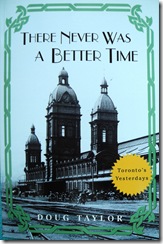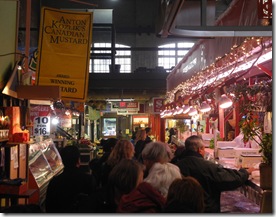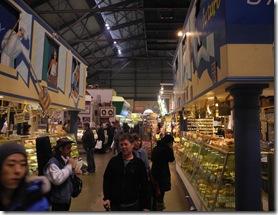The information below is from the book, “There Never Was A Better Time.” The novel is a tale of two mischievous young men, Jack and Ernie Taylor, who in 1921 immigrated to Canada from the small fishing village of Burin Bay in Newfoundland, in the days prior to Confederation. Their first employment was at McNamara’s market gardens, located in the open fields below the Davenport Road hill, on the west side of Bathurst Street. The McNamara brothers sold the produce from their fields at the St. Lawrence Market on Saturday mornings. Jack and Ernie were two of the employees who assisted in the retail sales.
This passage from the book describes the market and tells of the Taylor brothers departing the St. Lawrence Market on Christmas Eve in 1921.
Toronto’s St. Lawrence Market During the 1920s.
Toronto’s St. Lawrence Market of today commenced on 5 November of 1803 in the tiny town of York. It was named after the patron saint of Canada. The governor at the time of its inception, Peter Hunter, stipulated that it would occupy approximately five and a half acres at King and Front Streets. Its exact size and location, as well as the various buildings, had changed throughout the years, but since its inauguration, there had always been a market on the site.
On Saturday mornings during the autumn of 1921, the McNamara brothers rented tables in the north building of the St. Lawrence Market at Front and Jarvis Streets. The old redbrick market building on the south side of Front Street, had been serving the citizens of Toronto for many decades. It was a favourite gathering place for shoppers eager for fresh produce, as well as an assortment of preserves and jams from the farmers’ kitchens. People strolled and mingled as they vied for the freshest items at the cheapest prices. Hawkers shouted their wares and winked at the women to entice them to their stalls. It was a world of strong-smelling cheeses, opaque-eyed fish, fine cuts of meat, heaping mounds of colourful vegetables, and farm-fresh eggs. Bushels were filled with ripened fruit. Lifeless turkeys, chickens, and ducks hung from long poles above the tables or in the backs of trucks, the birds’ heads having been chopped off earlier in the day.
Live birds, crowded into wooden crates, were crammed haphazardly among the stalls and wagons. The heads of the doomed occupants noisily protruded through the bars of the cages. Occasionally, a rooster crowed, perhaps sensing that its final dawn had already passed.
Outside the market, on the east side of the building, people parked their carts and trucks. Horses munched from leather bags of oats, while their owners loaded into the backs of the wagons the sacks of potatoes and onions that they had just purchased. English sparrows noisily chirped and fluttered under the horses’ feedbags, competing for any oats that spilled to the ground. Several times throughout the day, the horses were led to the black cast-iron troughs to quench their thirst. Birds perched on the rim of the troughs, noisily scolding the intruding horses. Some farmers had brought bales of hay in their carts to feed their horses. It was a scene that seemed to belong to long-ago painters’ canvases or an engraving of a market during York’s colonial times.
The city maintained horse-watering troughs throughout the main streets of Toronto. Despite the many automobiles, most farmers still transported their fruits and vegetables by horse and wagon. By 1921, however, because the city was expanding rapidly, more and more produce was required. Market gardens within the city, such as McNamara’s, and others that were close to the city were unable to meet the demand. Farmers from as far away as fifteen or twenty miles now travelled to Toronto on a Saturday morning. Growers were gradually replacing their horse-drawn wagons with trucks. They parked many of these vehicles inside the market buildings, employing the back of the trucks as stalls, selling the vegetables and meats directly from them. The spaces between the trucks created aisles, where the shoppers strolled to examine the goods.
Finally, the honey-sunshine days of autumn drew to a close, and the yuletide season swiftly approached. On the final day before Christmas, Saturday 24 December, Jack and Ernie worked at the St. Lawrence Market to sell the last of McNamara’s carrots, onions, and potatoes, as well as the fresh flowers from the greenhouses. Throughout the market, yuletide decorations were present in abundance. Sprays of mistletoe glistened among the displays of imported oranges and lemons. Evergreen branches hung on the racks amid the sausages. The few remaining Christmas trees were now going for only thirty-five cents. Large, red paper bells and green garlands hung from the booths, trucks, and long tables.
Jack and Ernie thought about the mellow days of autumn, when the tables at the market had been heaping with the fruits of the harvest and the shoppers had crowded around to purchase the fresh produce from the McNamara gardens. They remembered how they had smiled at the pretty girls while helping them to choose vegetables.
In those earlier months, their employment had seemed secure. However, they now knew that with the close of the market at the end of the day, their jobs were terminated. Though the events of the autumn of the year were only a few weeks in the past, they now seemed like “the good old days.” They thought about their mother’s garden in Burin and the family gathering around the kitchen table at the homestead on Gun Point. This was to be their first Christmas away from home. The market and other wonders of Toronto were unable to overcome their homesickness.
By 5 pm on Christmas Eve, the stands were mostly empty of goods, and most of the shoppers had departed for the warmth of their homes. Geese had been the favourite fowl of the season, and not one remained for sale in the market—nor anywhere else in the city, for that matter. There were no turkeys, either—they had been in short supply and had disappeared in the early afternoon. The man dressed in the Santa Claus outfit, who had strolled all day among the tables and carts, was beginning to droop. The final hour, for both worker and shopper, had finally arrived.
Jack and Ernie cleared the McNamara tables and loaded the few remaining sacks of potatoes and carrots into the wagon. John McNamara shook their hands and handed them each an envelope containing a small bonus. Imparting a weary sigh, he smiled and said, “A very merry Christmas.”
As the Taylor brothers left the market, powdery snow settled on the streets and the rooftops. The curtain had closed on the final public scene of the yuletide pageant. In this year of 1921, Christmas Day, with all its love, mystery, and nostalgia, had quietly taken centre stage.
A link to the book, “There Never Was a Better Time,” https://tayloronhistory.com/there-never-was-a-better-time/
The author’s Home Page ; https://tayloronhistory.com/
Toronto’s St. Lawrence Market today, at the Christmas season.


